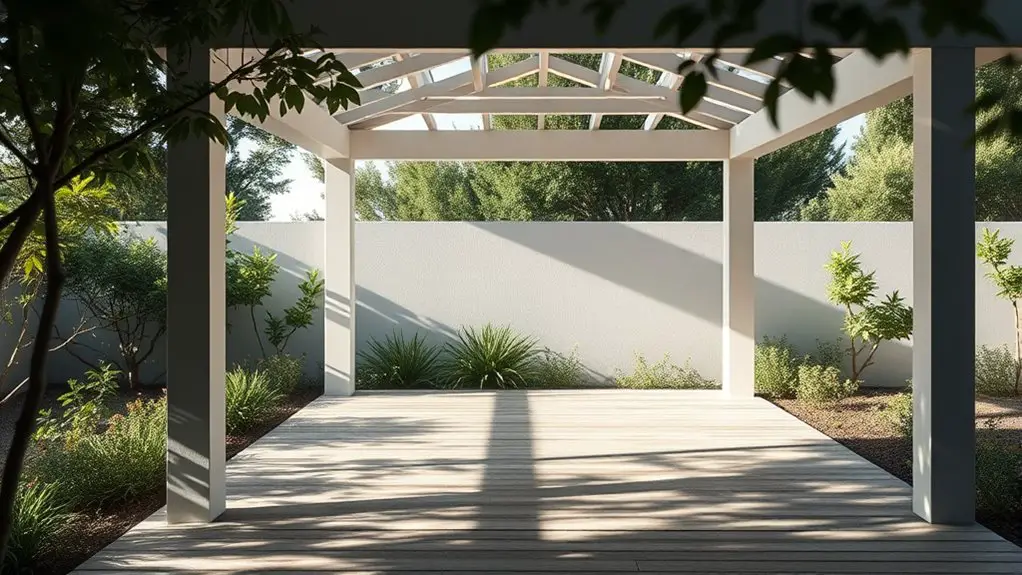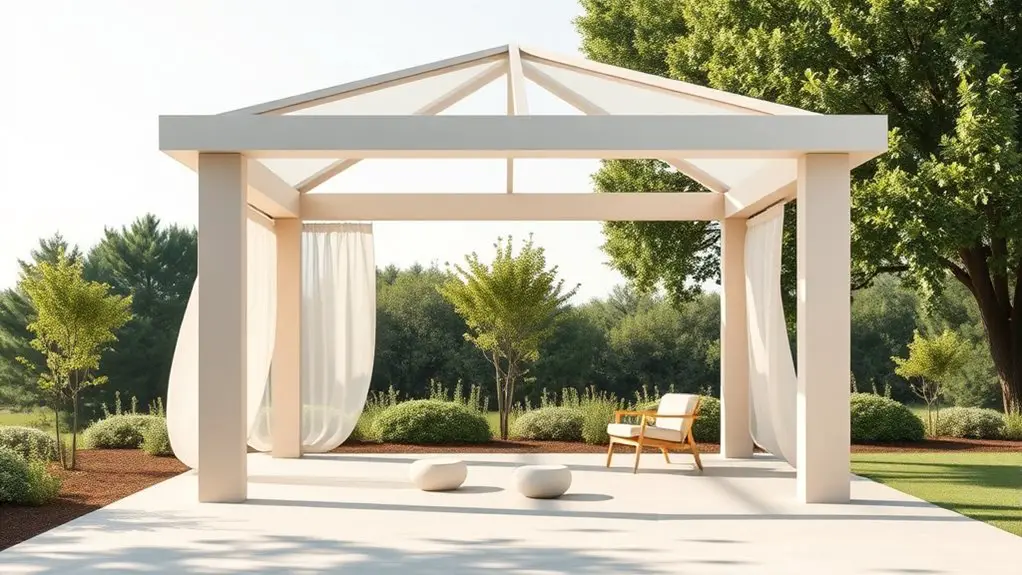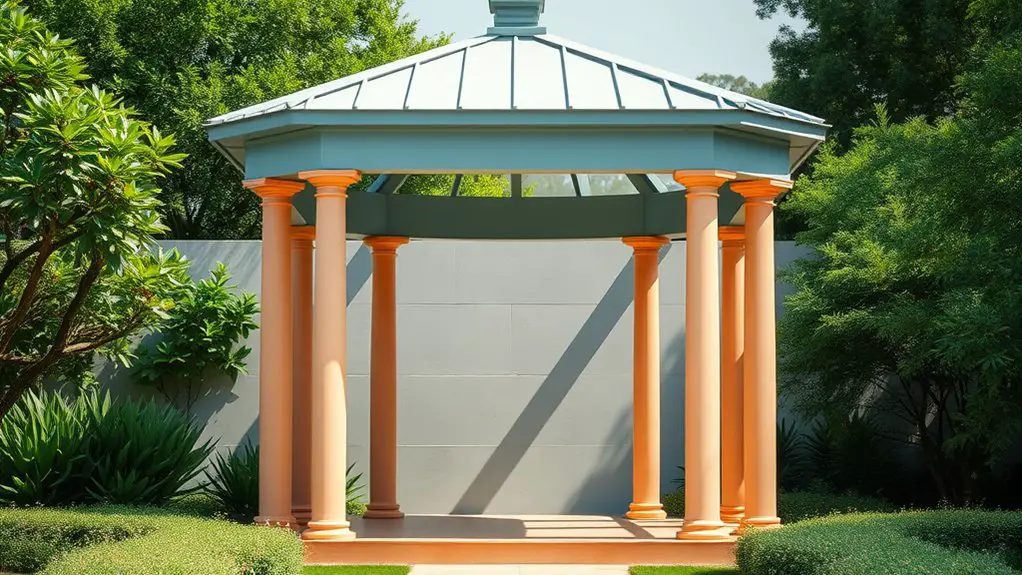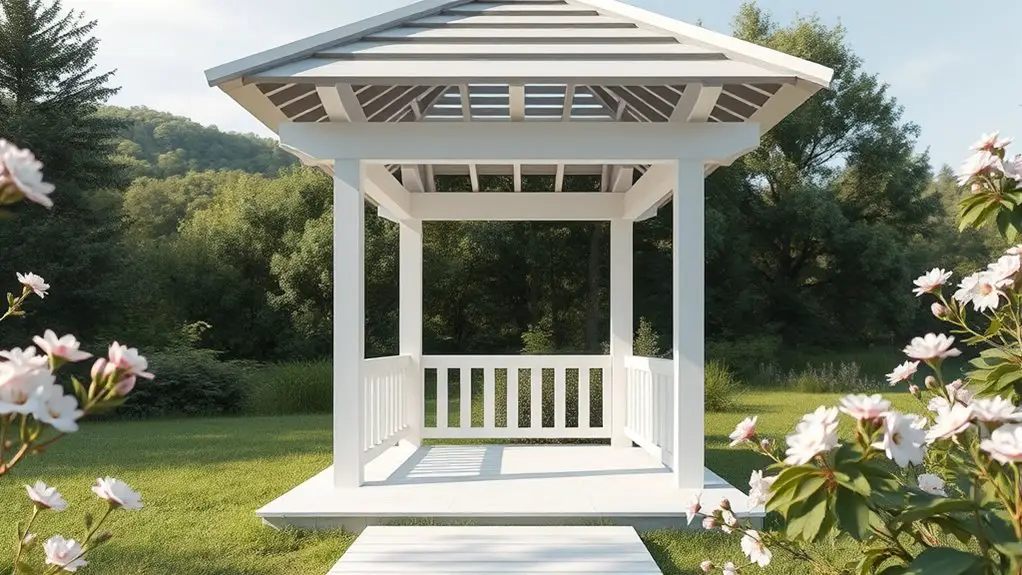To create a minimalist gazebo, choose a simple color palette that complements natural elements. Soft neutrals, earthy tones, or monochromatic shades evoke serenity and enhance the space’s tranquility. Aim for harmony by balancing complementary and contrasting colors, allowing the beauty of the materials to shine through. Keep décor minimal with natural textures and well-placed greenery. This thoughtful approach creates an inviting atmosphere. Discover how to refine your design further for the perfect outdoor escape.
Understanding Minimalism in Design

While you might think minimalism is just about simplicity, it’s actually a thoughtful approach that prioritizes functionality and clarity in design. At its core, minimalism embodies functional simplicity, stripping away the unnecessary to reveal the essential. This intentional design philosophy encourages you to create spaces that resonate with your values and lifestyle, promoting a sense of freedom from clutter.
Imagine a gazebo that elegantly balances form and function, where every element serves a purpose. The clean lines and unobtrusive features invite you to savor the surrounding nature rather than distract from it. By choosing materials that are both durable and aesthetically pleasing, you can achieve a harmonious blend of beauty and utility. Minimalism isn’t merely about what you leave out; it’s about thoughtfully selecting what remains, ensuring each component contributes to your overall vision. Embrace this liberating approach, and let your design reflect the essence of who you are.
Choosing Your Color Palette
Selecting the right color palette is essential for achieving a minimalist gazebo that truly reflects your aesthetic vision. To start your journey, consider these color selection tips that emphasize simplicity and harmony. Aim for a palette that resonates with your environment, utilizing soft neutrals, earthy tones, or monochromatic shades for a serene feel. Additionally, ensure that your color choices complement the material and style of the gazebo to enhance its overall appeal.
Here’s a quick reference table to inspire your choices:
| Color Family | Suggested Shades | Mood/Feelings |
|---|---|---|
| Neutrals | Beige, Gray, White | Calm, Relaxed |
| Earthy Tones | Olive, Terracotta | Grounded, Warm |
| Monochromatic | Various Blues | Tranquil, Cohesive |
This palette inspiration can guide you in creating a space that not only looks good but also feels free and inviting. Embrace the beauty of simplicity as you design your dream gazebo!
The Psychology of Colors

Colors aren’t just visual elements; they carry emotional weight and can greatly impact your mood. When you’re choosing hues for your minimalist gazebo, consider how certain shades can evoke tranquility or energy. By selecting calming colors, you can create a serene retreat that enhances your outdoor experience.
Color Associations and Emotions
The vibrant hues you choose for your gazebo can greatly influence the emotions it evokes. Understanding color meanings allows you to curate an inviting space that resonates with your spirit. Here are three colors and their emotional responses:
- Blue: This tranquil hue promotes calmness and serenity, perfect for relaxation.
- Green: Associated with nature, it fosters balance, renewal, and harmony, making your gazebo a peaceful retreat.
- Yellow: A cheerful and uplifting color, it inspires joy and creativity, inviting lively gatherings.
Impact on Mood
When you think about how a color palette shapes your gazebo, consider the psychological effects these hues can have on your mood. Colors aren’t just aesthetic choices; they actively influence your emotional landscape. For instance, warm tones like red and orange can evoke energy, sparking creativity and excitement. In contrast, cooler shades like blue and green often bring tranquility, encouraging relaxation and reflection. The right combination of colors can enhance your outdoor experience, creating a space where you feel alive and free. By understanding these color effects, you can harness their power, crafting a gazebo that doesn’t just look good but also elevates your spirit. Ultimately, your choice of colors can profoundly shape your daily mood and emotional well-being.
Choosing Calming Hues
How do you want your outdoor space to feel? Choosing calming hues can transform your gazebo into a serene retreat. Think about incorporating colors that evoke peace and tranquility. Here are three suggestions:
- Serene Blues: These shades bring a sense of calmness, reminiscent of clear skies and tranquil waters. They help reduce stress, making your space inviting.
- Earthy Greens: These colors connect you to nature, promoting relaxation and grounding your space. They create a harmonious atmosphere that encourages connection with the environment.
- Soft Neutrals: Complementing your primary colors, these shades can enhance the overall calm, allowing your serene blues and earthy greens to shine.
Complementary vs. Contrasting Colors

When designing your minimalist gazebo, understanding color theory is essential to achieving harmony. You’ll want to explore complementary combinations that enhance visual appeal, versus contrasting elements that add dynamic tension. Finding the right balance between these approaches can transform your outdoor space into a fascinating retreat.
Understanding Color Theory
Color theory serves as the foundation for creating an appealing minimalist gazebo, especially when you explore the dynamics of complementary and contrasting colors. Understanding these relationships can enhance color harmony and convey powerful color symbolism.
- Complementary Colors: These are pairs of colors that sit opposite each other on the color wheel. They create vibrant contrasts, making your gazebo stand out.
- Contrasting Colors: Unlike complementary, these colors aren’t directly opposite but still differ greatly. They can add depth without overwhelming the senses.
- Color Balance: Striking the right balance can evoke emotions and set a mood, ensuring your gazebo feels inviting and serene.
Selecting Complementary Combinations
Building on your understanding of color theory, selecting the right complementary combinations can elevate your minimalist gazebo’s aesthetic. Think about pairing colors that sit opposite each other on the color wheel, like a vibrant blue with a warm orange. This creates striking color harmony, drawing the eye while maintaining a clean, uncluttered look. When you use these combinations, you not only enhance the visual appeal but also convey a sense of balance and sophistication. For example, a soft gray gazebo with rich green accents can evoke tranquility, while a bold black structure paired with a bright yellow can energize the space. Ultimately, embracing these complementary colors will enrich your design aesthetics, allowing your gazebo to stand out in its simplicity.
Balancing Contrasting Elements
Although you may be drawn to bold contrasts, balancing these elements in your minimalist gazebo design is essential for achieving visual harmony. By thoughtfully considering contrasting textures and shapes, you can create a space that feels cohesive yet dynamic. Here are three ways to strike that balance:
- Texture Play: Combine smooth surfaces with rough materials to add depth without overwhelming the senses.
- Shape Contrast: Use geometric forms alongside organic shapes to create intrigue while ensuring they complement each other.
- Color Pairing: Opt for a dominant color while introducing a contrasting hue sparingly, keeping the overall look clean and intentional.
Incorporating Natural Elements
When you design a minimalist gazebo, weaving in natural elements can enhance its aesthetic and create a harmonious connection with the surrounding environment. Consider using natural materials like wood or stone to build your structure. These organic textures not only blend seamlessly with nature but also evoke a sense of tranquility. Incorporating plants or even a small water feature can further enrich the space, inviting the soothing sounds of nature. Selecting the right wood, such as cedar and redwood, ensures both durability and aesthetic appeal for your gazebo.
Here’s a simple way to visualize your choices:
| Natural Element | Emotional Impact |
|---|---|
| Reclaimed Wood | Warmth and Comfort |
| River Stones | Serenity and Stability |
| Climbing Vines | Growth and Energy |
Painting and Finishing Techniques
To achieve a polished look for your minimalist gazebo, mastering painting and finishing techniques is essential. Using the right approach will elevate the simplicity of your design while embracing freedom in your creativity. Here are three key techniques to contemplate:
- Brush Techniques: Use a variety of brush strokes to create texture. A dry brush technique can add subtle depth, while a smooth finish can enhance the sleek lines of your gazebo.
- Finish Options: Choose matte for a natural look or semi-gloss for a slight sheen. These finishes can protect the wood while complementing your color palette.
- Layering Colors: Experiment with layering different shades to achieve a harmonious gradient. Start with a base coat, then add highlights to accentuate architectural features. Consider selecting a paint with weather resistance to ensure durability and protection against the elements.
Accessorizing With Minimalist Decor
As you seek to enhance your minimalist gazebo, incorporating carefully chosen decor can considerably elevate its aesthetic without overwhelming the clean lines of your design. Embrace decor simplicity by selecting minimalist accessories that serve both form and function. Think of natural materials like bamboo or light-colored wood for furniture, maintaining a cohesive color palette that complements your gazebo.
Introduce a few well-placed plants in sleek pots to breathe life into the space while keeping the environment serene. Consider a single statement piece, like a geometric sculpture, to draw the eye without cluttering. Soft textiles, such as a neutral throw or a single cushion, can add comfort while maintaining that uncluttered feel. Remember, each accessory should enhance your gazebo’s essence, offering a sense of freedom and tranquility that invites you to relax and enjoy the beauty of your surroundings. Additionally, incorporating shade structures can improve comfort while blocking UV rays and maintaining a minimalist aesthetic.
Maintaining Your Gazebo’s Aesthetic
Maintaining your gazebo’s aesthetic requires a thoughtful approach to both upkeep and design choices. To guarantee your gazebo remains a serene escape, consider these three key aspects of gazebo maintenance for aesthetic preservation:
- Regular Cleaning: Keep surfaces free of dirt and debris. Use gentle cleansers that won’t harm your color palette, preserving the minimalist charm.
- Routine Inspections: Check for wear and tear. Address any issues—like peeling paint or loose boards—immediately to maintain a polished look.
- Seasonal Touch-Ups: Refresh the color scheme with a new coat of paint or stain as needed. This keeps your gazebo looking vibrant while aligning with your chosen palette. Additionally, ensure to perform regular inspections to assess the condition of the frame and fabric, which is crucial for long-term aesthetic appeal.
Frequently Asked Questions
What Materials Work Best for a Minimalist Gazebo Structure?
When building a minimalist gazebo, consider the harmony of wood selection and a sturdy metal frame. These materials not only guarantee durability but also offer a sleek aesthetic, allowing your space to breathe and feel open.
How Do I Choose Furniture for a Minimalist Gazebo?
When choosing furniture for your minimalist gazebo, focus on functional designs and durable materials like metal or wood. Opt for sleek lines and neutral colors, ensuring each piece complements the serene environment while providing comfort and utility.
Can I Use Patterns in a Minimalist Design?
Absolutely, you can incorporate subtle patterns and textures in minimalist design. Just guarantee they’re understated, enhancing your space without overwhelming it. Think delicate lines or soft weaves that add depth while maintaining a serene atmosphere.
What Lighting Options Suit a Minimalist Gazebo?
For your minimalist gazebo, consider soft ambient lighting and natural illumination. Use strategically placed LED fixtures or lanterns to create a serene atmosphere, allowing you to enjoy the space while appreciating its simplicity and elegance.
How Do I Ensure My Gazebo Blends With Its Surroundings?
To guarantee your gazebo blends seamlessly, focus on color harmony with natural elements. Choose shades that mirror the surrounding landscape, incorporating earthy tones and textures. This creates a tranquil retreat, inviting you to relax in nature’s embrace.

